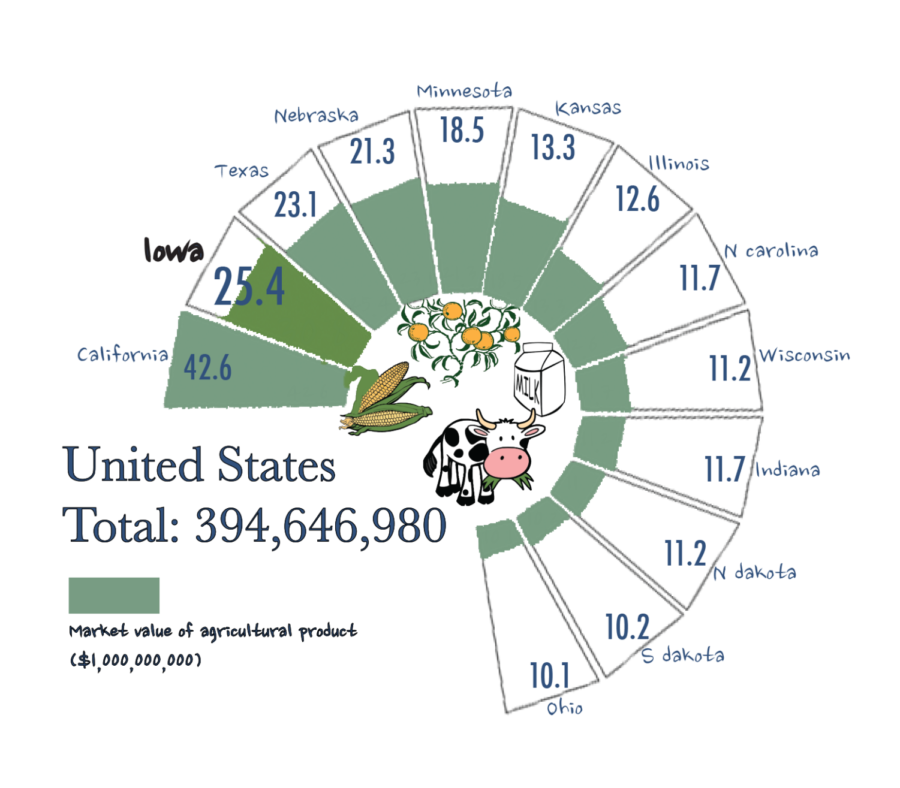Iowa ranked 2nd in nation for sales in all three agricultural categories
The graph indicates the market value of agricultural products.
March 14, 2014
According to the USDA Census of Agriculture, the state of Iowa is second overall in its total amount of agriculture sales compared to the rest of the United States. The census was taken based on the 2012 data.
John Lawrence, associate dean of the College of Agriculture, said that he wasn’t surprised by the increase in ranking. The market value of agriculture in Iowa was $30.8 billion dollars.
Lawrence said the increase in value is due to the higher prices of corn, soybeans, cattle and hogs.
“Every five years, the USDA does a census of agriculture across the whole nation,” Lawrence said.
According to the census, Iowa passed Texas in the total value of production, passed Illinois in the value of crops and passed California in the value of livestock. Iowa is second in all three categories.
“Overall [with livestock and crops], we went from $20 billion to $30 billion,” Lawrence said.
Another reason why there has been an increase in the value of agriculture is world supply and demand, Lawrence said. There has been a growing demand of exports and a growing demand of grains for ethanol between 2007 and 2012.
On the livestock side, Lawrence said there has been a growing global demand of pork and beef.
Lee Schulz, assistant professor of economics-AGLS and extension livestock economist, said that Iowa has seen a greater consumer demand for beef and pork products. He also said that people are paying higher prices for beef and pork products, which offsets the quantity decrease in Iowa.
While Iowa has seen an increase in demand of agriculture globally, Lawrence said that we have also seen shortages.
The price of production in 2012 went up because it was a drought year. Schulz said that Iowa planted a record number of acres of crops, but it didn’t produce the anticipated yield, which affected the feed prices for livestock.
“We’ve seen the national herd in cattle decrease,” Schulz said.
Compared to Iowa, the largest decrease is in other states. Texas has had decreasing numbers in livestock for sometime, Schulz said. They had a drought in 2011 and 2012, which has impacted their production ability.
While the acreage devoted to crops didn’t increase significantly from 2007 to 2012, Lawrence said there was an increase in value. The increase in value was due to growing demand in ethanol and exports.
“About a fourth of our Iowa soybean production goes to China,” Lawrence said.
Iowa’s soybean production is much larger than what it used to be, and Iowa is also exporting to other parts of the world.
This increase in value of agriculture has put a lot more dollars into rural Iowa, Lawrence said. Unlike other industries, Iowa has agriculture in every county of the state.
Lawrence said that a lot of this wealth in rural Iowa was spent on inputs, including seed corn, chemical fertilizers and machinery purchases from companies like John Deere.
The agricultural wealth in the state also has an impact on Iowa State and its students, as many of these students fill agricultural jobs.
“We’re at record enrollment at Iowa State and we’re a record enrollment in the College of Agriculture and Life Sciences,” Lawrence said.
There is high demand for graduates from the College of Agriculture and Life Sciences. Lawrence said they have seen a 75 percent increase in enrollment since 2005, and they still have an over 97 percent job placement rate for graduating students.
Lawrence said, “The strength of the agricultural economy is driving that demand for students.”







